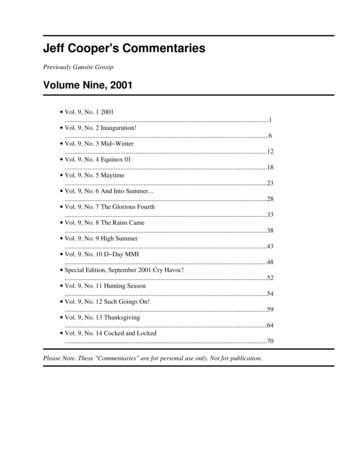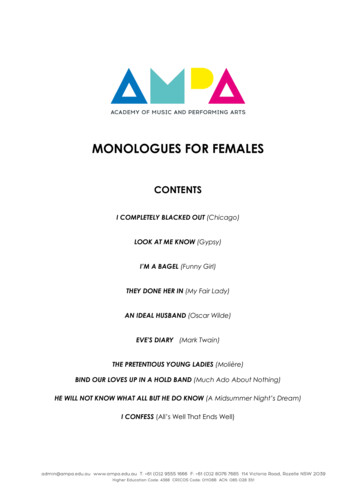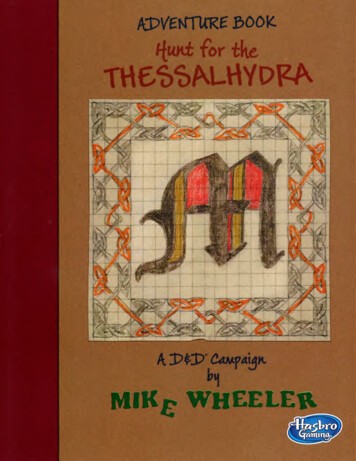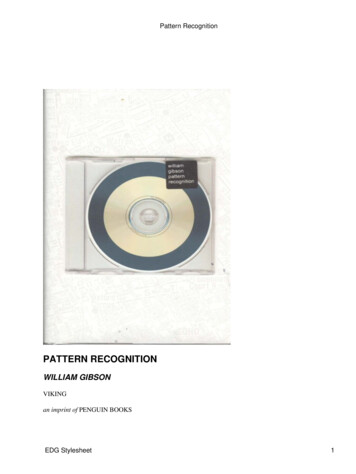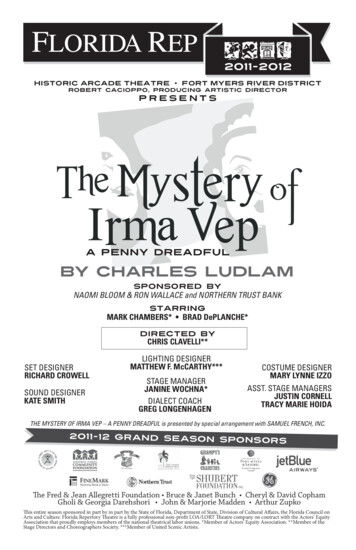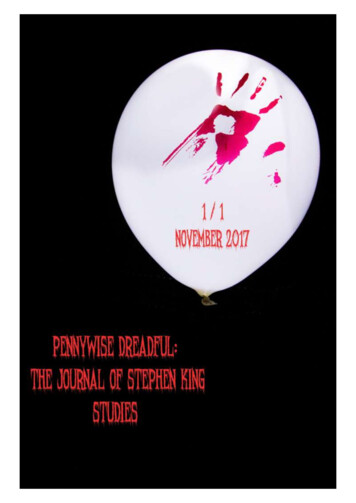
Transcription
1
Pennywise DreadfulThe Journal of Stephen �———Issue 1/1November 20172
EditorsAlan GregoryDawn StobbartDigital Production EditorRachel FoxAdvisory BoardXavier Aldana ReyesLinda BadleyBrian BakerSimon BrownSteven BruhmRegina HansenGary HoppenstandTony MagistraleSimon MarsdenPatrick McAleerBernice M. MurphyPhilip L. SimpsonWebsite: https://pennywisedreadful.wordpress.com/Twitter: @pennywisedreadFacebook: https://www.facebook.com/pennywisedread/3
ContentsForeword p. 2“Stephen King and the Illusion of Childhood,” Lauren Christie p. 3“‘Go then, there are other worlds than these’: A Text-World-Theory Exploration ofIntertextuality in Stephen King’s Dark Tower Series,” Lizzie Stewart-Shaw p. 16“Claustrophobic Hotel Rooms and Intermedial Horror in 1408,” Michail Markodimitrakis p. 31“Adapting Stephen King: Text, Context and the Case of Cell (2016),” Simon Brown p. 42Review: “Laura Mee. Devil’s Advocates: The Shining. Leighton Buzzard: Auteur, 2017,” Jill Goad p. 58Review: “Maura Grady & Tony Magistrale. The Shawshank Experience: Tracking the History of theWorld's Favourite Movie. New York, NY: Palgrave Macmillan, 2016,” Dawn Stobbart p. 59Review: “The Dark Tower, Dir. Nikolaj Arcel. Columbia Pictures, 2017,” Andrew Elliot p. 60Review: “The Mist. Spike, 2017,” Yann Teyssou p. 621
ForewordGreetings Constant Readers, and welcome to issue 1/1 of Pennywise Dreadful: The Journal of Stephen KingStudies.Pennywise Dreadful is a peer-reviewed online journal that seeks to exhibit quality scholarship on the workof the American writer, Stephen King. Our intent is to create a platform for the publication of researchwhich will sustain an emergent critical demonstration of King’s worth as a subject of scholasticinterrogation initiated by publications such as Tony Magistrale’s Landscape of Fear (1988) and John Sears’Stephen King’s Gothic (2011), and which has continued through the publication of a special issue of ScienceFiction Film and Television Studies on Stephen King’s Science Fiction, edited by Simon Brown and ReginaHanson (2017), in addition to Brown’s forthcoming monograph, Screening Stephen King: Adaptation and theHorror Genre in Film and Television (2018).Pennywise Dreadful represents a timely scholastic enterprise which recognises Stephen King’s heightenedprofile in academic and cultural spheres, as well as the enduring popularity of his literary fiction. Sincewe instigated the journal, and its accompanying podcast, in September 2016, King has continued to writeprolifically, co-writing Gwenty’s Botton Box with Richard Chizmar and Sleeping Beauties with son OwenKing. Several filmic and television adaptations of King’s work have also been released in the last twelvemonths. Nicholaj Arcel’s The Dark Tower and Andrés Muschietti’s IT brought King’s fiction to thecinema screen, while Mr Mercedes, The Mist and Gerald’s Game were all adapted for television. Thepropagation of King’s cross media convergence was highlighted further in July 2017 through the BritishFilm Institute’s announcement of Stephen King on Screen, a season of film and television dedicated toStephen King to commemorate the occasion of his seventieth birthday.Pennywise Dreadful welcomes contributions from scholars and academics that offer innovative, originaland scholarly rigorous readings of King’s oeuvre, and that examine the tensions and intertextualresonances that cultivate relationships between King’s fiction and contemporary literature and culture.The journal is a celebration of the cultural longevity of King’s work and provides a forum for presentingnew research on King’s fiction and his contemporary context.Those celebrations begin at Rereading Stephen King: Navigating the Intertextual Labyrinth at KingstonUniversity on Saturday 11 November 2017; an event which culminates in Pennywise Dreadful’s officiallaunch. Both the papers presented at the symposium, and the articles in this journal will afford bothestablished and emerging voices in King Studies to showcase King’s status as an enduring literary andcultural phenomenon as well as continuing the process of addressing King’s apparent lack of criticalrecognition for his contribution to American letters.Alan GregoryDawn Stobbart2
Stephen King and the Illusion of ChildhoodLauren ChristieUniversity of DundeeAbstractStephen King and the Illusion of Childhood explores the application of magic and illusion inIT and The Shining. This article details the function of child characters in both novels,and demonstrates how their presence heightens and accelerates terror.In IT, Pennywise the Clown changes his appearance according to each character’spersonal fears, acting as a manifestation of their individual traumatic memories. Thefirst section of this article explores the need for children to acknowledge and confronttheir fear. Instances that are uncomfortable to the child result in an inadvertenttendency to repress this fear, destined to remain dormant until moments of stress anduncertainty where it will plague the individual throughout later life. The eventualconfrontation of Pennywise symbolises each character confronting their darkestchildhood fear in order to move on.While Pennywise embodies a variety of external fears and childhood monsters, TheShining’s Jack Torrance represents the fine margin between sanity and insanity. Asopposed to a visible monster, Jack is a restructured creation of modern society: a silentmonster suppressing a violent temperament and plagued by self-doubt and eventualinsanity. The Shining explores the danger of a family unit pressurised by isolation(physical and societal), a wealth of internal psychological battles, and the malevolentforces at work in the Overlook hotel. These forces prey on Jack’s weaknesses in orderto accelerate his insanity and attempt to kill his family.King’s obsession with childhood is well documented in his own writing Through the perceptions of hischild characters, King suspends the “rational” world to let in the nightmare world; he clears away the dulledsenses of adulthood to open up the “marvellous third eye” of imagination and heightened perception Kingdeclares it no less than his mission as a horror writer to make adults into children once again (DanseMacabre 407).1Many iconic Stephen King novels explore a world of monsters, only visible through the ‘marvelous thirdeye’ of imagination. Nowhere is this more noticeable than during childhood. Samantha Figliolaaccentuates the link between imagination and perception, pinpointing the fact that children are not yetrestricted by the “rational” adult world. This article will consider Stephen King’s illusion of childhood byhighlighting key factors in two of his most popular novels: nostalgia for childhood and understanding ofreality in IT, and vulnerability as experienced through innocent eyes in The Shining. Children naturallypossess a robust imagination. They are certain both magic and evil exist in their world, revealing theSamantha Figola. 1998. “The Thousand Faces of Danny Torrance” In Discovering Stephen King’s “The Shining” edited by TonyMagistrale, 54-61, Wildside, Maryland: Wildside Press. p. 54.13
wonder (and fear) of an active mind. For every fanciful creature the imagination can create, there lurks amonster coexisting in the shadows. This belief in the unbelievable fades with age; many adults areimmune to the monsters of childhood. Stephen King’s literary children remind the adult reader of thisworld long forgotten. King ensures a loosened grip on reality, allowing the reader to embrace theirimagination (and all of the nightmares therein).The adult tendency to repress fear and imagination is present in both novels. Repression istraditionally understood as ‘Some emotion, or feeling- which has been submerged The appearance of the repressed create an aura of menace and “uncanniness,” both in [Sigmund] Freud’ssense of “unheimlich” - something that becomes apparent although one feels it “ought” to remain hidden’(Clemens 1999, 4). Fear of the ‘unheimlich’ compliments Figliola’s reasoning on the effectiveness ofKing’s work. Adults abide by the strict rules of rational logic (suppressing juvenile fears). They areimmune to supernatural events due to a diminished imagination, requiring proof in order to believe. ‘Toexperience fear, calamity, and human savagery, however vicariously, is also to gain some appreciation oftheir reality’ (Clemens 1999, 6). King invites adults to rediscover childhood fear. In accepting thisinvitation, repressed ‘phobic pressure points’ (King 1981, 19) are brought to the forefront of the mind(re-establishing their existence). The interior disintegration of Jack Torrance demonstrates the danger ofallowing these monsters to fester.An overactive imagination during childhood is the cause and origin of many so-called monsters.They are created, expanded upon, and then destined to reside in the closet of a child’s imagination untilsummoned by uncertainty or fear. King declares that ‘we make up horrors to help us cope with the realones The dream of horror is in itself an out-letting it may well be that the mass-media dream ofhorror can sometimes become a nationwide analyst’s couch’ (King 1981, 27). Tony Magistrale andMichael Morrison argue that regardless of how well ‘Americans [insulate] themselves against therandom intrusiveness of violence’, one can never predict an erratic mind. ‘children are pushed fromrooftops for candy bars. Some people escape reality of such horrors by denying their existence Horror prefers to see the reality flushed out into the open watching our collective and personalfears affords the audience control over such experience’ (1996, 2-3). Realising the frequency andclose proximity of horror enables society to acknowledge and process these fears. Edwin Casebeerdiscusses King’s ability to ‘create fiction about that which we would rather avoid is his appealunderstandable in a way that affirms our willingness to deal with dilemmas?’ (1996, 42).Uncomfortable issues that are ordinarily overlooked are given centre stage, resulting in a mixture ofshock and therapy for the reader. It can be argued that King’s obsession with collective anxieties,originates from traumatic experiences in his own childhood:The event occurred when I was barely four I had gone off to play at a neighbour’s house- ahouse that was near a railroad line I came back as white as a ghost. I would not speak forthe rest of that day It turned out that the kid I had been playing with had been run over by afreight train while playing on or crossing the tracks. I have no memory of the incident at all To which Janet Jeppson (who is a psychiatrist as well as a novelist) said: “But you’ve beenwriting about it ever since.” (King 1981, 102-103).Jeppson correlates a link between King’s subject matter and the influence this event has had on hispsyche. King’s writing focuses on traumatic incidents and anxieties in order to draw personal horrors outof the subconscious and into the open. King admits to the plethora of internal monsters that plaguehim on a daily basis. Writing about them raises awareness, thereby limiting their control. Regardless oforigin, failing to confront the monster at this early age results in a latent fear within the depths of themind.King creates monsters that represent the wealth of internal struggles children face whilst growingup. For maximum impact to the adult reader, King’s work often reflects themes which are present infairy tales. Examples of corrupt adults, ‘King’s child-heroes must at some point do battle against the evils affiliated with, adulthood’ the strength of friendship, ‘his protagonists, like Grimm’s Hansel and4
Gretel form strong small-group allegiances to overcome the adult evil’, and an ongoing supernaturalpresence (Magistrale 1992, 36). The key point to note is the desire to target ‘the evils affiliated with,adulthood’ such as parental neglect, alcoholism and child abuse. This alerts the adult reader to thejuvenile helplessness of innocent children. ‘King considers fairy tales the scariest existing stories thestories for children form a conduit leading to what adults call horror stories’ (Stengrell 2007, 111-112).Acknowledging this link solidifies a positive connection between the two genres. In order to truly terrify,the writer must target weaknesses of an adult reader. ‘Fairy tales [make] us regress into childhood.King employs fairy tales to address the child inside every adult’ (ibid: 111-112). Heidi Strengellobserves that King wishes to create adult fairy tales in order to transport readers to a state of juvenilewonder, adrenaline and fear. The adrenaline experienced from horror is not dissimilar to the childlikeadrenaline evoked from Jack rushing down the beanstalk to flee the giant.Manifestation and Magic in ITIT explores illusion, deceit and the power of imagination. Effective disguise provides a contrast betweenthe external and internal appearance of the monster, and of Derry itself. The first section of IT tests thepower of friendship and bravery of the seven child protagonists (the Losers’ Club). As the novelprogresses these characters return to Derry as adults summoned by the reawakening of IT. As with theirpredecessors, ageing has resulted in repressed memories and loss of imagination. Returning to Derrysignifies the necessity of each character to confront fears of their past. As with The Shining, children areforced to realise that not all adults can be trusted. Adult negligence is evident throughout the novel,‘Derry’s adults profess a love for their children, but there are no concrete examples of panic surrounding the disappearance of so many young people the seven children are brought together byvirtue of parental neglect or cruelty Denborough realises that the imaginative gap separating childrenfrom their parents is responsible for their blindness’ (Magistrale 2003, 185). These adults who are notintentionally cruel are merely ignorant. This ignorance results in their blindness regarding the monstersof Derry.Personal turbulence is often utilised to build a relationship between the reader and character,‘Like the fairy tale, the horror story relies upon the breakup of familial relationships, death, isolation,separation. In both genres the reader is forced to engage these issues [and] confront them’ (Magistrale1992, 34). King places his child characters in traumatic situations as a form of therapy for the reader,these issues can only be resolved through confrontation. On discussing the inspiration for the novel, ‘Ihad something fixed in my mind about bringing together all my thoughts on monsters and the children’stale, “Three Billy Goats Gruff,”. I walked all over town I would notice these four-foot-deep drifts ofdead flowers This is what we don't see aboveground’ (Magistrale 2003, 3-4). King’s exploration ofBangor demonstrates a contrasting world above and below ground. This children’s tale he refers toexplores three goats tempted by the promise of food, ‘They loved to eat sweet grass in the distancethey could see a field that was full of lush sweet scrummy grass, but alas there was only one way to get toit- over a rickety bridge over a stream. But under the bridge lived a terrifically terrifying terrible trollcalled Trevor’ (Asbjørnsen 1841). In order to reach paradise these goats must first confront thedangerous troll. Bravery and strength triumph over evil in the conclusion, as the Big Billy Goat ‘bent hishead and bravely charged at the troll tossing him into the stream below never to be seen again’(Asbjørnsen 1841). ‘Bravely’ charging towards the monster mirrors the bravery required to destroy IT.Creating a horror story that is thematically influenced by a children's tale subconsciously transports thereader back to their childhood. IT becomes a modern day fairy tale, as a group of children unite to battlea monster that is a culmination of childhood fears. Critic Jack Zipes considers the positive influence offairy tales, ‘I believe that we have been attracted to fairy tales because they are survival stories withhope However, only certain ones remain with us attach themselves to our brains so that we willremember them’ (2006, 27). This inbuilt desire that good will prevail is a feeling that remains fromchildhood, and one that is often applied to horror stories.5
Amalgamating different viewpoints and time periods demonstrates the confidence of the Losers’Club as children, and their apprehension as adults; thus offering synthesis for the reader. A subconsciousdesire to forget results in memory gaps as adults – memories that gradually return the closer theprotagonists are to the vicinity of Derry. During the initial series of phone calls, Stan Uris describes tohis wife a vague awareness of memories resurfacing ‘Sometimes I have a bad dream Somethingthat should be over and isn’t My whole pleasant life has been nothing but the eye of some storm Idon’t understand But then it just fades. The way dreams do’ (King 1987, 62-64). King is disclosingkey information to merit an explanation, but withholds enough to maintain intrigue. Stan’s word choicein describing this ominous feeling as a ‘bad dream’ and his awareness of an ‘eye of some storm’represents the resurface of memories and monsters. The underlying feeling of terror begins to revealStan’s fragile mind:The bathroom was lit by fluorescent tubes. It was very bright. There were no shadows. Youcould see everything, whether you wanted to or not Stanley lay His head had rolled so farback on his neck His mouth hung open His expression was one of abysmal, frozenhorror He had slit his inner forearms open He had dipped his right forefinger in his ownblood and had written a single word in two huge, staggering letters his final impression onthe world. It seemed to cry out at her: IT (King 1987, 68-69).The harsh lighting in this passage mirrors the harsh reality of the situation for both Stan (with the returnof IT) and for his wife. Lack of shadow represents the exposure of repressed memories that normallyreside in the silhouette of the subconscious, the bright lights symbolising Stan’s recollection, and suicidereflecting his inability to cope. Stan’s suicide is a representation of the decline of the fairy tale in modernsociety, ‘The fairy tale had lost its deeper significance by the beginning of the twentieth century becauseit had not and could not develop the means to deal with the torn relationship between the imaginationand reality’ (Zipes 2006, 92). Stan’s suicide represents horror seeping into reality. The frequency ofhorror in society has destroyed previous boundaries between imagination and reality.Anxiety and panic are exhibited from each character as they are summoned back to Derry. Kingaccentuates this through interior monologue. Richard Tozier considers that ‘ at some point during thenext hour it was as if he had died and had yet been allowed to make his own funeral arrangements’(King 1987, 71). Ben Hanscom explains fear, and loss of memories:I was just a kid What scared me was realising I’d forgotten everything about being a kid Did you ever hear of having an amnesia so complete you didn’t even know you hadamnesia. I’m scared almost insane by whatever else I may remember before tonight’s over, buthow scared I am doesn’t matter, because it’s going to come anyway (King 1987, 90-91).Acceptance of the inevitable return is present as Ben explains ‘how scared I am doesn’t matter, becauseit’s going to come anyway’. Stan’s suicide and Richie and Ben’s ominous feelings offer an ideal seguebetween the first phase of the novel, and the reunion of the Losers’ Club as adults. Although they areunable to pinpoint exact reasoning, an overwhelming desire to avoid Derry is felt by each character.King’s gradual revelation of information mirrors the gradual return of memories for the characters.The pacing of this work heightens the imminent danger of the situation. A slower pace is appliedto describe the exact details of character deaths, and the appearance of various monsters. King’semployment of in-depth character portrayal ensures a close bond between reader and character;therefore when a character is brutally murdered, it is more horrific for the reader. Once the Losers’ Clubreturn to Derry, alongside the literal application of homecoming each character is aware of the passingof time:although It may be immortal we are not when It awakes, It is the same, but a third of ourlives has gone by. Our perspectives have narrowed; our faith in the magic that makes magicpossible, has worn off And now, now that we no longer believe in Santa Claus or the trollunder the bridge, It is ready for us. Come on back, It says Bring your jacks and your marbles and6
your yo-yos! We’ll play. Come on back and we’ll see if you remember the simplest thing of all: how it is to bechildren, secure in belief and thus afraid of the dark (King 1987, 880).The Losers’ Club express their internal anxiety regarding ageing. This has not only made them physicallyweaker, but has diminished their mental agility and belief in the unbelievable. Referring to childhoodimages such as ‘jacks’, ‘marbles’ and ‘Santa Claus’ King conjoins these emblems of innocence with theunshakeable faith of childhood ideals. ‘Secure in belief and thus afraid of the dark’ refers to the union ofconfidence, imagination and juvenile fear. This passage highlights the necessity that all adults musteventually return to their juvenile state in order to confront the monster of their past. The reawakeningof IT has summoned the children back to Derry, in their current adult state. Revisiting favoured hauntsfrom their past accelerates the return of memories:He turned one of the skateboard’s scuffed wheels It called up something very old in Bill’schest Bill put the skateboard on the sidewalk and put one foot on it In his mind Billsaw himself on the kid’s avocado-green skateboard his bald head gleaming in the sun He saw himself coming down on his ass “You were guilty of two major lapses, MrDenbrough. The first was mismanagement of a skateboard. The second was forgetting thatyou are now approaching forty years of age” “I guess not,” he said (King 1987, 589-590).Derry is inviting Bill back to his past through this skateboard. This passage emphasises the lack ofbravery, and the adult tendency to over-analyse a situation. These thoughts originate with an initial ‘veryold’ instinctive desire to ride the skateboard, then transform into overwhelming anxiety. Bill is applyingadult imagination, tarnishing an innocent activity with doubt and self-preservation. John Sears highlightsthis mixture of desire and fear, as he explains ‘It explores at great length the mixed desire for and horrorof returning to and re-acting childhood events’ (2011, 16). The detailed description of the ‘avocadogreen skateboard’ and the young child starkly contrasts with Bill’s ‘bald head gleaming in the sun’,furthering the unnatural combination of an adult in a child’s world. Bill can only imagine injury andconsequence.Traumatic flashbacks frequently interrupt the internal journey back to childhood:Too many shadows Richie suddenly wondered what he would do if a hand or a clawsprang out of those leaves Richie heard snarling sounds He saw loafers descend Richiestood frozen, suddenly knowing what was coming for them. The face of the Werewolfsuddenly swam out of the dark There was no zipper on the thing’s jacket; instead there werebig fluffy orange buttons, like pompoms. The other thing was worse. It was the other thing thatmade him feel as if he might faint, or just give up and let it kill him. A name was stitched on thejacket RICHIE TOZIER (King 1987, 375-381).Stricken with anxiety at the thought of ‘a hand or a claw’ coming out to grab him is a typical example ofimagination removing logic in order to accelerate terror. This thought process is one King admits topersonally, ‘I don't like to sleep with one leg sticking out if a hand ever reached out from under thebed and grasped my ankle, I might scream The thing under my bed waiting to grab my ankle isn'treal I also know that if I’m careful to keep my foot under the covers, it will never be able to grab myankle’ (King 2007, 7). An overactive imagination enhances the reality of Richie’s terror. Richie is the onlycharacter that can identify the monster and therefore is ‘frozen’ with fear. Acknowledging the lack ofzipper represents the reality of the situation; there is no way of unmasking something that is real. The‘orange buttons, like pompoms’ are a stark reminder of the culprit behind these illusions. Recognition ofhis own name on the jacket evokes feelings of terror due to the fact Pennywise binds the monster toRichie, as it is a manifestation of his personal fear.From the macabre opening of IT, one particular disguise has resulted in decades of nightmaresand numerous cases of coulrophobia: Pennywise the Dancing Clown. King frequently transformsinnocent objects (a paper boat), into objects of fear:7
“Want your boat, Georgie?” The clown smiled. George smiled back. He couldn’t help it; it wasthe kind of smile you just had to answer He reached forward and then drew his handreluctantly back. “I’m not supposed to take stuff from strangers How did you get downthere?” “Storm blew the whole circus away. Can you smell the circus, Georgie?” Georgeleaned forward he could smell cotton candy and the cheery aroma of midway sawdust.And yet under it all was the smell of dark stormdrain shadows (King 1987, 25-26).Ellipses elongate George’s death and the introduction of Pennywise. George’s inability to resist theclown’s allure is highlighted as he insists the smile is ‘the kind of smile you just had to answer’. Thissimultaneously emphasises horror of the clown and the naivety of a child. King’s decision to present ITas a childhood figure (symbolic of the circus, a childish pleasure) offers a demonic twist. The paper boatthat George built with the help of his brother (a brotherly bonding experience), and the smell of thecircus further Pennywise’s trap. At this point he is so enthralled by the magic, George is unaware of hisproximity to a monster. Vulnerability is demonstrated as each child reveals their encounter with IT:I saw the clown. He was handing out balloons to kids Silver suit, orange buttons, whitemakeup on his face, big red smile. I don’t know if it was lipstick or make-up, but it looked likeblood it scared me. And while I was looking at him, he turned around and waved at me, likehe’d read my mind And that scared me worse the music too loud, the sky too blue his bloody grin too red and too wide, a scream turned upside-down (King 1987, 700).Innocence and horror are present as Pennywise distributes balloons. The reader is aware of the dangerof Pennywise, however the parents remain unaware. This furthers the separation between adults andchildren with regard to awareness of danger. Details such as ‘the music too loud, the sky too blue’completes a layer of exaggeration that is present with illusion, surroundings appearing too focused to benatural. This horrific illusion is furthered as characters recollect the make-up, and a smile that is either‘lipstick’ or ‘blood’. The telepathic quality of Pennywise fuels the power of the monster, offering themost horrific entity personalised to each individual. Pennywise is symbolic of the corrupt adult luringchildren, ‘When adults think of clowns, they often associate them with childhood, but the children always view the clown as an “adult” that preys upon children. Pennywise’s jocular persona first lures theunsuspecting child with the promise of pleasure and fun, and then turns revealing that underneath is actually an adult wearing a disguise’ (Magistrale 2003, 186). A clown provides a dual meaning foradults and children. Although an adult views the clown as a symbol of childhood, the child questions thefigure underneath the make up.Make-up and magic, objects that will attract children (balloons) and scents (‘smell the fairGeorgie?’) are successfully combined to create a powerful, seemingly indestructible monster. Once theillusion is broken, reality sets in with the decaying smell of the monster underneath. The child charactersrealise that the secret to conquering IT is by understanding identity, ‘It was a werewolf for y-y-you DDon’t you s-s-see? It was a wuh-wuh-werewolf for y-you because y-you saw that duh-humb movie Ithink It’s a gluh-gluh glamour. The Himalayans called it a tallus or taelus, which meant an evil magicbeing that could read your mind and then assume the shape of the thing you were most afraid of’ (King1987, 663-664). Once the characters grasp the origin of the creature they are equipped to tackle thismonster.The nightmare of Derry is concluded through the victory of the Losers’ Club. Mirroring thereturn of memories at the beginning of the novel, leaving Derry triggers memories beginning to fade:He awakens from this dream unable to remember exactly what it was he has dreamed aboutbeing a child again he thinks that it is good to be a child, but it is also good to be grownup Or so Bill Denbrough sometimes thinks on those early mornings after dreaming, when healmost remembers his childhood, and the friends with whom he shared it (King 1987, 1116).The fading memories of childhood signifies a loss of imagination. Relating events to a dream, ‘unable toremember exactly what it was’, offers a balance as each character returns to their state of ign
2 Foreword Greetings Constant Readers, and welcome to issue 1/1 of Pennywise Dreadful: The Journal of Stephen King Studies. Pennywise Dreadful is a peer-reviewed online journal that seeks to exhibit quality scholarship on the work of the American writer, Stephen King. Our inten
